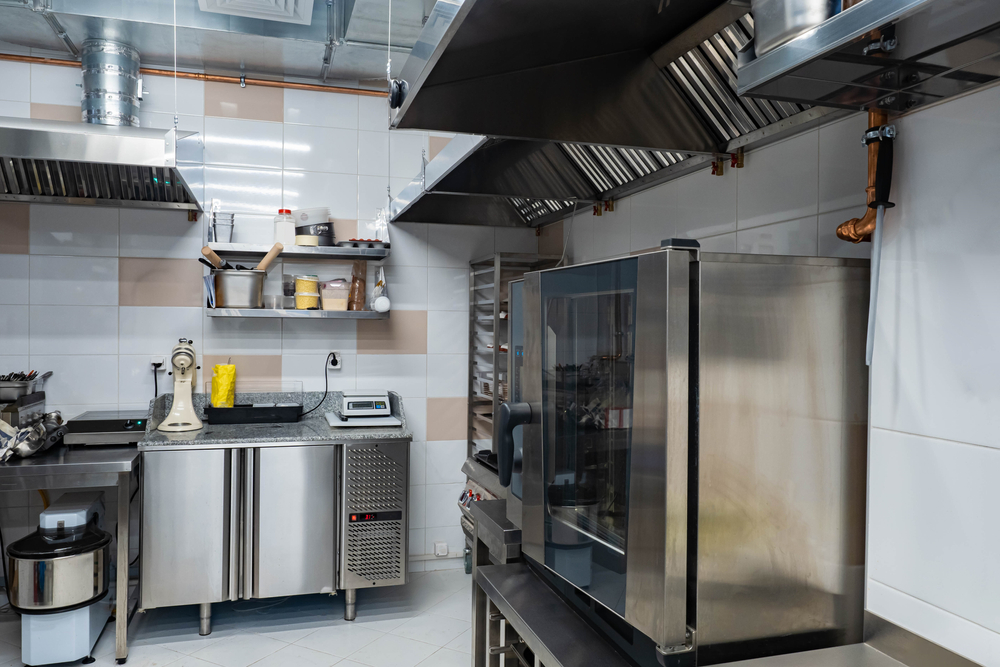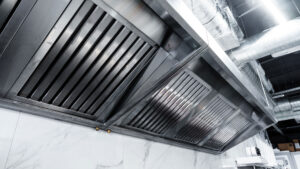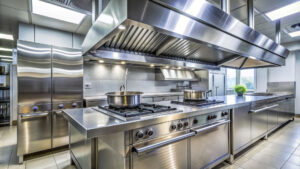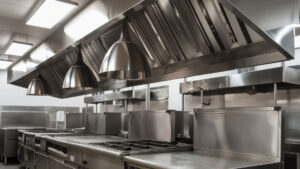Ever wondered what makes a commercial kitchen safe? It’s often the commercial kitchen hood above the cooking area. Knowing the rules for hoods is key for safety, efficiency, and following the law in kitchens. These rules cover everything from handling grease vapors to managing heat and steam.
For example, hoods must overhang the cooking area by at least 6 inches. They also need to be installed up to 4 feet above the cooking area. Getting this wrong is not acceptable.
Key Takeaways:
- Type I hoods are designed to manage grease, heat, and smoke, requiring fire suppression systems, while Type II hoods handle steam, vapor, and odors.
- Construction materials for hoods must be non-combustible with specific minimum thicknesses for steel and stainless steel based on hood type.
- Proper installation should include adhering to overhang and height requirements for safety and efficiency.
- Local jurisdictions may have more stringent requirements than the International Mechanical Code, necessitating thorough research before installation.
- Make up air systems are necessary to replace the air removed by exhaust systems, and regular maintenance is required to ensure proper function.
Design and Layout Specifications for Commercial Kitchen Hoods
Designing a commercial kitchen requires careful planning to meet safety and function needs. It’s vital to follow kitchen hood guidelines for good ventilation and safety compliance.
First, the hood must overhang cooking surfaces by at least 6 inches. This ensures all cooking fumes are caught. The hood’s height also matters: 1.5 feet for surfaces without flames, 2 feet for those with, and 3.5 feet for charbroilers. The maximum height is 4 feet above cooking areas.
Choosing the right materials is also key. Type I hoods, for high grease, need steel at least 0.0466 inches thick or stainless steel at 0.0335 inches. Type II hoods, for steam, must be steel no thinner than 0.0296 inches, stainless steel at 0.0220 inches, or copper at 24 ounces per square foot.
Strong support is crucial for hood installations. These supports must hold the hood and ductwork safely. Fire safety rules also require Type I hoods to be at least 18 inches from flammable materials. Grease ducts must also stay away from these materials.
The capture and exhaust rates are important too. Wall-mounted hoods have lower rates than single-island hoods, which are lower than proximity hoods. The exact rates depend on appliance type and hood length, often in cubic feet per minute (cfm) per linear foot. For example, proximity hoods can work well at 150 cfm per linear foot over medium-duty equipment. This helps capture emissions without wasting energy.
In conclusion, following these guidelines is crucial for a safe and efficient commercial kitchen. By meeting overhang, material, fire safety, and exhaust rate standards, a kitchen can ensure safety and function.
What are the Rules for Commercial Kitchen Hoods?
The rules for commercial kitchen hoods are set to keep food service areas safe and efficient. Both Type I and Type II hoods have specific guidelines. These ensure they meet the commercial kitchen hood code requirements.
Type I hoods are essential for high-grease cooking. They must remove smoke and grease well. They are made from steel or stainless steel, with certain thicknesses.
To avoid fires, Type I hoods must be at least 18 inches from flammable materials. They also need a label showing the minimum exhaust flow rate in CFM per linear foot.
Type I hoods have grease filters at specific heights:
- 1.5 feet above surfaces without exposed flames
- 2 feet above surfaces with exposed flames and burners
- 3.5 feet above appliances with exposed charcoal or charbroilers
It’s crucial to clean Type I hoods regularly to prevent fires and extend their life. The joints and seams must be welded or brazed for a tight seal. They should also be at least 18 inches from combustibles for safety and maintenance access.
Type II hoods are needed for steam-generating appliances. They are made from steel, stainless steel, or copper sheets. These hoods manage moisture well, so no grease filters are needed. Their exhaust outlets must be placed safely to avoid risks to people and buildings.
When installing commercial kitchen hoods, a minimum overhang of 6 inches is required. The vertical distance above the cooking surface should not exceed 4 feet. The joints and seams must be sealed tightly to prevent leaks and make cleaning easier.
Also, all electrical parts of kitchen hoods must meet standards to prevent overheating and short circuits. Appliances under Type I hoods need code-compliant fire suppression systems for extra safety.
Following these strict rules helps kitchen operators keep their cooking areas safe and compliant. This ensures efficient food service operations.
Conclusion
Knowing and following the right rules for commercial kitchen hoods is key for safety and success. Following these standards helps keep kitchens safe and running well. Regular checks and upkeep are important to avoid fires, which cause about 8% of restaurant fires, says the National Fire Protection Association (NFPA).
Rules say kitchen hood systems must be checked often. How often depends on the equipment used. For example, solid fuel kitchens need checks every month, while electric ones need them every six months. Not following these rules can lead to big fines. Keeping good records, which vary by state, is also crucial to show you’re following the rules.
Keeping kitchen hoods in good shape is essential. They need to be cleaned by pros at least every three months in most kitchens. This costs between $300 and $800, based on the size and condition of the system. By following NFPA 96, kitchens can stay safe and avoid fires.
It’s the owner’s job to keep these systems in check and follow NFPA rules. Scheduling regular checks is key for any kitchen’s success. By following the rules, kitchens can be safer, more efficient, and avoid legal trouble.



